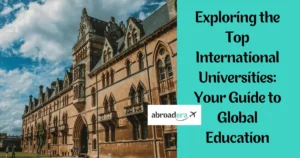Studying abroad is a dream for many students around the world, offering unparalleled opportunities for personal growth, academic enrichment, and cultural immersion. However, navigating the process of studying abroad can seem daunting without proper guidance.
In this comprehensive guide, we’ll outline a step-by-step procedure to help aspiring international students fulfill their dream of studying abroad.
Step 1: Research and Choose Your Destination
The first step in studying abroad is to research and choose your destination wisely. Consider the following factors while selecting your study destination:
- Quality of education
- Availability of your desired study program
- Cost of living
- Language requirements
- Cultural fit
- Potential career opportunities
Consult online resources, university websites, student forums, and alumni networks to gather information and insights about different study destinations.
Step 2: Select Suitable Study Program and Institution
Once you’ve chosen your destination, the next step is to select a suitable study program and institution that aligns with your academic interests, career goals, and personal preferences.
Explore the range of programs offered, including undergraduate, graduate, and exchange programs, and consider factors such as program curriculum, faculty expertise, research opportunities, campus facilities, and student support services. Attend virtual or in-person information sessions, webinars, and campus tours to get a firsthand experience of the institution and its offerings.
Step 3: Check Admission Requirements and Eligibility Criteria
Before applying to study abroad, it’s essential to check the admission requirements and eligibility criteria for your chosen study program and institution.
This may include academic qualifications, standardized test scores (such as SAT, ACT, GRE, or GMAT), English language proficiency scores (such as IELTS, TOEFL, PTE, or Duolingo), letters of recommendation (LORs), statement of purpose (SOP), resume or curriculum vitae (CV), and any additional application materials specified by the institution. Be sure to meet all deadlines and submit your application well in advance to allow for processing time.
Step 4: Arrange Finances and Explore Funding Options
Studying abroad can be a significant financial investment, so it’s essential to arrange your finances and explore funding options in advance. Calculate the total cost of tuition, accommodation, living expenses, travel, insurance, and other miscellaneous expenses, and develop a realistic budget to manage your finances effectively.
Explore scholarship opportunities, grants, fellowships, and financial aid programs offered by universities, government agencies, non-profit organizations, and private foundations to offset the cost of studying abroad. Consider part-time work or internships to supplement your income and gain valuable work experience.
Step 5: Apply for Student Visa and Fulfill Immigration Requirements
Once you’ve been accepted into your chosen study program and institution, the next step is to apply for a student visa and fulfill immigration requirements to study abroad legally. Research the visa application process and requirements for your chosen destination, including visa types, application forms, documentation, biometrics, visa fees, and processing times.
Prepare all required documents, such as a valid passport, acceptance letter, financial statements, health insurance, proof of accommodation, and visa application forms. Submit your application to the appropriate embassy or consulate. Attend any required interviews or appointments and follow up on your application status until you receive your visa.
Step 6: Arrange Accommodation and Prepare for Arrival
With your visa in hand, it’s time to arrange accommodation and prepare for your arrival in your chosen study destination. Research accommodation options, such as university dormitories, private rentals, homestays, or shared apartments, and secure housing that meets your preferences, budget, and location preferences.
Familiarize yourself with local transportation options, healthcare services, banking facilities, emergency contacts, and other essential information to ensure a smooth transition to your new environment. Pack necessary belongings, travel documents, and essentials for your journey, and stay updated on any travel restrictions or health guidelines due to the ongoing COVID-19 pandemic.
Step 7: Embrace Study Abroad Experience and Stay Engaged
Finally, embrace the study abroad experience with an open mind, curiosity, and enthusiasm for learning and growth. Immerse yourself in the local culture, language, customs, and traditions, and seize every opportunity to explore new places, meet diverse people, and engage in meaningful experiences both inside and outside the classroom.
Stay connected with family and friends back home, while also building new connections and friendships with fellow students, professors, and members of the community. Take advantage of academic resources, extracurricular activities, student clubs, and cultural events to enhance your educational experience and make the most of your time abroad.
Conclusion
In conclusion, studying abroad is a transformative journey that requires careful planning, preparation, and perseverance. By following this step-by-step guide, aspiring international students can navigate the complexities of studying abroad with confidence and embark on a rewarding educational adventure that will shape their future success and global perspective. Whether you’re pursuing an undergraduate, graduate, or exchange program, studying abroad offers invaluable opportunities for personal, academic, and professional growth that will last a lifetime.







